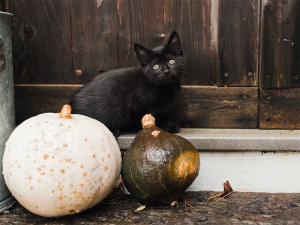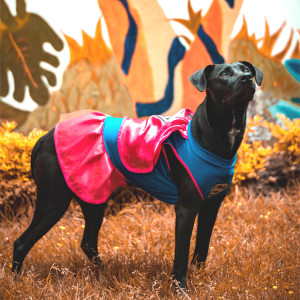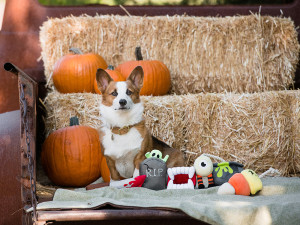The Top 5 Halloween Hazards for Dogs
Scarier than The Conjuring: Last Rites.
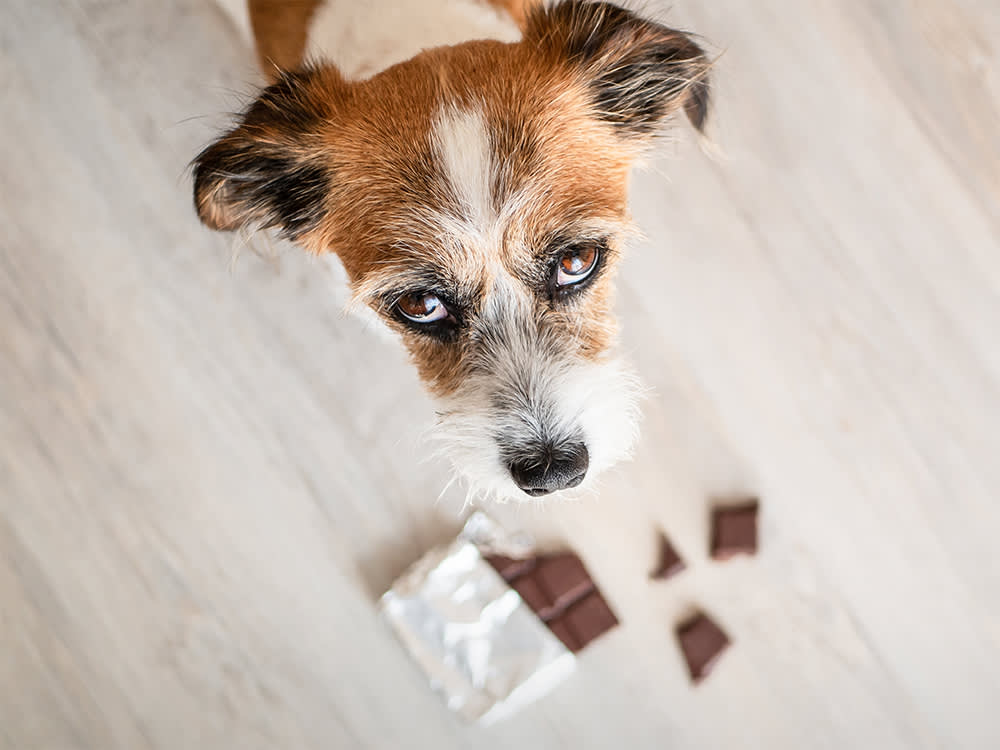
Share Article
Being a pet parent during the Halloween season requires a whole lot of thinking ahead — for one, you have to figure out how to find an outfit that’s both comfy for your pup and that fits perfectly with your The Summer I Turned Pretty group costume vision. But there’s a less fun kind of planning, too: Before the festivities arrive, you’ll want to make sure your pet is safe from a few holiday dangers. In an effort to take some of the scare out of your holiday, keep an eye out for these Halloween safety hazards.
Halloween pet hazards
Chocolate
You probably already know this, but you gotta keep an eye on the candy bowl. Given the opportunity, most dogs will gladly snack on chocolate and other candy — wrappers included. Chocolate, especially dark or baking chocolate, can be super dangerous to pups. The compounds in chocolate that cause toxicity are caffeine and theobromine. In general, the darker chocolate is, the more dangerous it is. Depending on the amount and type of chocolate ingested, a pup’s symptoms can range from increased thirst, vomiting, belly discomfort, and restlessness to severe agitation, irregular heart rhythm, muscle tremors, high body temperature, seizures, and death.
If your pet has ingested chocolate, call your veterinarian or local animal emergency hospital. The vet can make a calculation, based on your pet’s body weight, to determine if what’s been ingested nears a toxic dose that requires treatment.
Xylitol
Candies containing the artificial sweetener xylitol can also cause problems. Even small amounts of xylitol can be highly toxic for dogs. Xylitol is widely used in sugar-free gum, as well as in sugar-free baked products. In people, xylitol doesn’t affect blood sugar levels, but in dogs, ingestion can lead to a rapid and severe drop in blood sugar levels (known as hypoglycemia).

The hypoglycemic dose for dogs is considered to be approximately 0.1 grams per kilogram of body weight. A typical stick of gum contains 0.3 to 0.4 grams of xylitol — which means that a 10-pound dog could be poisoned by as little as a stick and a half of gum. Dogs may develop disorientation and seizures within 30 minutes of ingesting xylitol-containing products, or signs may be delayed for several hours.
Some dogs who ingest large amounts of xylitol develop liver failure, which can sometimes be fatal. The dose necessary to cause liver failure is 1 gram per kilogram of body weight, which is about 10 times more than the dose for low blood sugar. This means a 10-pound dog could go into liver failure if they ingested an unopened package of gum, and sadly, this is not an uncommon occurrence. A pet who has ingested a product containing xylitol should be examined by a veterinarian as soon as possible.
Decorative pumpkins and corn
Decorative pumpkins are usually relatively nontoxic — but when they develop mold, they can wreak havoc on your pup’s digestive system. Decorative corn is of a higher concern; while corn itself is safe for dogs in small amounts, the cobs can pose a risk for obstruction in the intestines if ingested.
Costumes
As adorable as your pup might look in a silly Halloween costume, many pets can have adverse reactions to a constrictive outfit or its irritating materials. If your pup usually likes dressing up, make sure the costume isn’t annoying or unsafe by scheduling a dress rehearsal well before the big night.
Make sure your pet’s costume does not have small, dangling, or easily chewed-off pieces that your dog could choke on. Also, ill-fitting outfits can get twisted on external objects, or your pet, leading to injury. Your pet’s costume should not constrict their movement or hearing, or impede their ability to breathe or bark.
Take extra caution if your pet has sensitive skin. Even dogs with thick coats can have allergic reactions to the synthetic materials found in many costumes. If your pup seems itchy, distressed, or shows any abnormal behavior, consider letting them go in their birthday suit or in a festive bandana.
Door dangers
When trick-or-treaters start arriving, it’s best to keep pets in a room away from all the excitement. Too many strangers can be frightening and anxiety-inducing. When opening the door for trick-or-treaters, take extra care that your dog doesn’t dart outside.
In a worst case scenario, you want to always make sure your dog has proper identification. If they escape and become lost, a collar and tags or dog license — or better yet, a microchip — can be a true lifesaver, greatly increasing the chances that they will be returned to you. Make sure your pet’s microchip is registered in the system and your contact information is up to date. If you are unsure whether your pet’s microchip is active and properly registered, you can ask your veterinarian to scan them.
Consider your pet’s emotional well-being on Halloween
Does your pup’s job description include barking and defending whenever a new person arrives at your front door? Think about how your poor dog must feel on Halloween night when that doorbell rings dozens of times within the span of a few hours. Talk about emotional exhaustion! Consider the following options to preserve their wellbeing:
Keep your dog behind closed doors, ideally in a sound-proof part of your home.
Provide trick-or-treaters with a “help yourself” candy bowl on your front walkway.
Board your pets elsewhere on Halloween night.
Turn off your house lights and skip the holiday altogether. You and your dog can howl at the moon to celebrate instead.
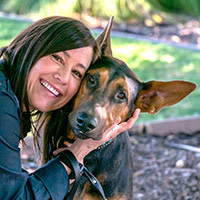
Dr. Shea Cox, DVM, CVPP, CHPV
Dr. Shea Cox is the founder of BluePearl Pet Hospice and is a global leader in animal hospice and palliative care. With a focus on technology, innovation and education, her efforts are changing the end-of-life landscape in veterinary medicine.
Related articles
![Black kitten sitting outside with pumpkins]()
How to Give Your Cat a Halloween That Won’t Make Them Hiss
Cats might be a symbol of Halloween, but that’s as far as they want it to go.
![black dog wearing a supergirl costume]()
Do Dogs Like Halloween Costumes? How to Dress Them Up So They Don’t Hate It
Even though they probably will.
![Black kitten sitting outside with pumpkins]()
How to Give Your Cat a Halloween That Won’t Make Them Hiss
Cats might be a symbol of Halloween, but that’s as far as they want it to go.
![Corgi dog sitting in the back of a rusty red truck in front of hay bales with pumpkins and Halloween toys around]()
26 Spooky Pet Toys and Treats to Haunt Your House
October is so cute it’s scary.
![Dog looking out of a red half-door]()
How to Stop Your Escape-Artist Dog From Making a Getaway
Dog trainer Pat Miller’s pro tips for preventing your pup from darting out the door.

